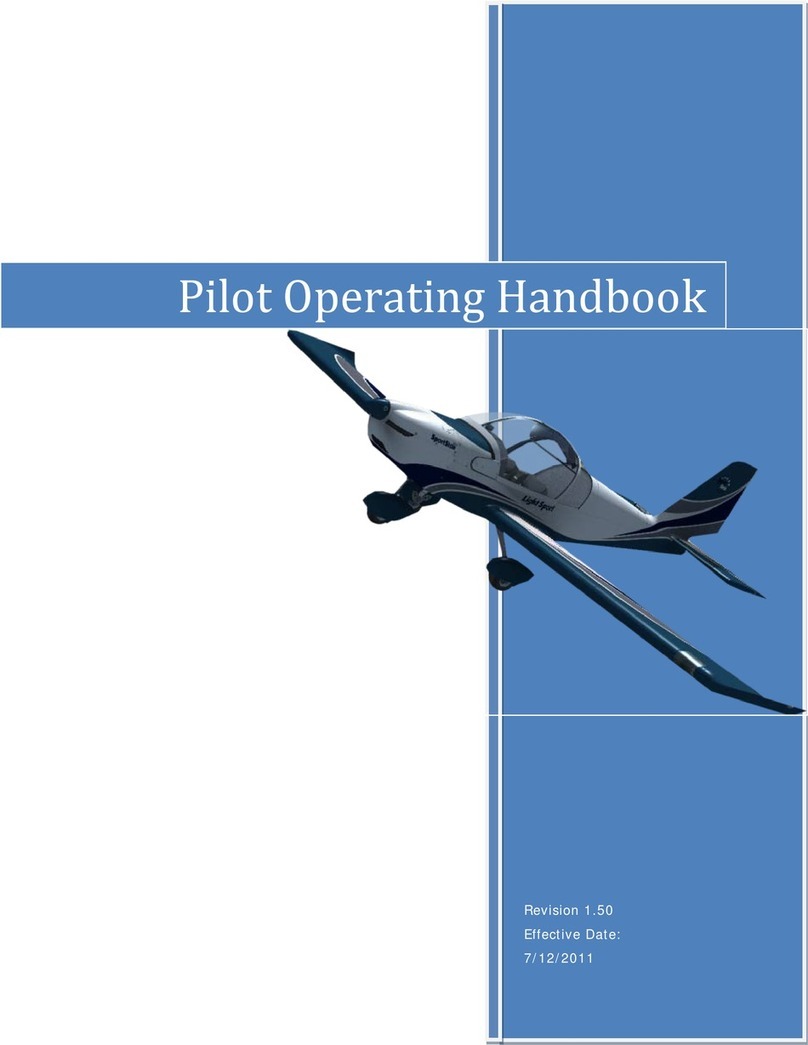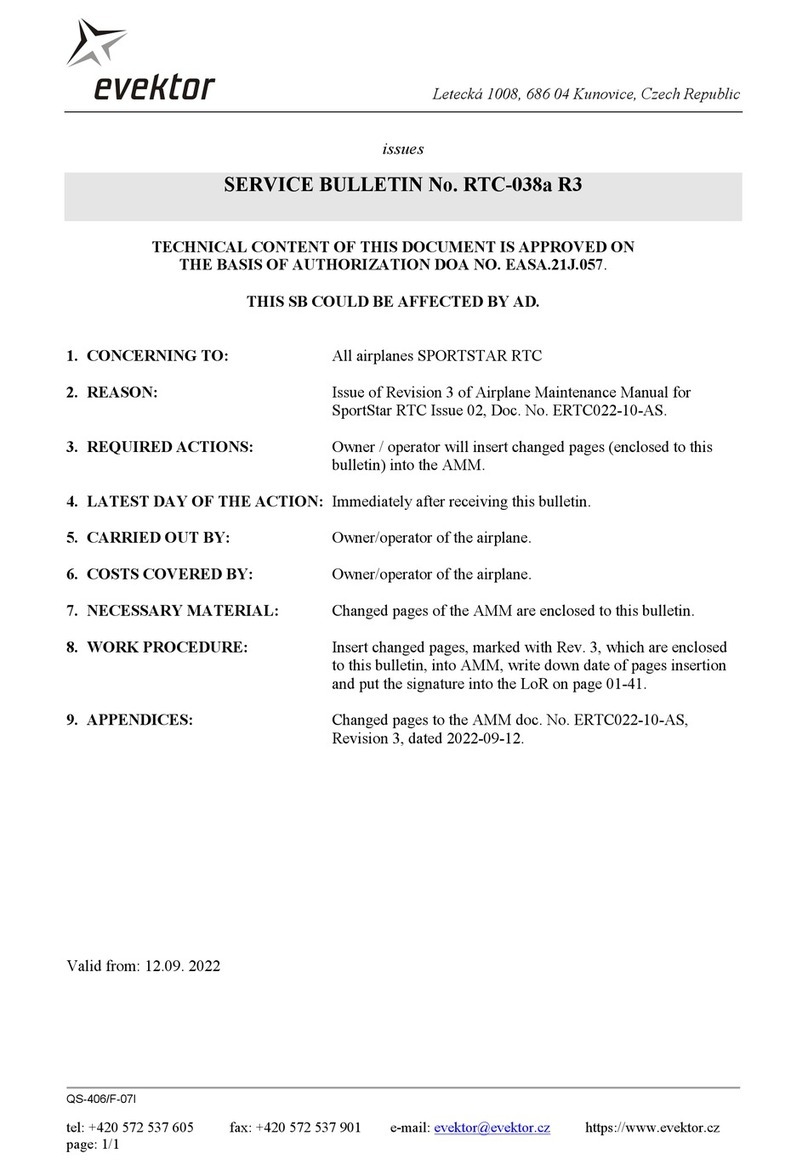Evektor EV-97 EuroStar SL Microlight Owner's manual

POH/EUR/02 Issue 5 Page 1 of 37
EV-97 EUROSTAR SL
MICROLIGHT
PILOT OPERATING HANDBOOK
POH/EUR/02

POH/EUR/02 Issue 5 Page 2 of 37
PILOT’S OPERATING HANDBOOK FOR AEROPLANE
EV-97 EuroStar SL Microlight
Model: EV-97 Eurostar SL Microlight
Registration: G-
Serial Nº:
This aeroplane must be operated in compliance with the information
and limitations contained herein.
This POH must be available on
board the aeroplane.
WARNING
This Aircraft is not fitted with a certified engine. A power failure can occur at any time.
Never fly over any area on to which a safe landing cannot be made in the event of an
engine failure
Flying in this and any aircraft can be dangerous either as the passenger or the pilot. You
agree to fly in this aircraft entirely at your own risk.
Any acute or long term medical conditions or the taking of any medications associated
with any acute or long term condition will increase your risk of flying in this aircraft safely
and may lead to you becoming incapacitated at the controls. This includes the taking of
any social or recreational drugs, alcohol, diving using an aqua lung , recent blood
donation, cold or flu, ear infection.
On board the aircraft please ensure that loose articles are secured before flight. Loose
items can jam the controls leading to a loss of control.
Stalling, spinning or any aerobatic manoeuvres during any stage of flight may lead to a
loss of control.
The parachute handle safety pin can be removed at the pilots discretion before flight.
Failure to do so may result in the pilots' inability to deploy the parachute due to
incapacity, adverse G and or aerodynamic forces resulting from mid air collision or loss of
control.

POH/EUR/02 Issue 5 Page 3 of 37
AMENDMENT RECORD
Issue
Details of Change
Date
Authorised
1 Initial issue 12 May 2014
2
Section 7.10 Electrical system. Pg. 33
Changes to distribution and services.
Included electric pre-start system
27 August 2014
3
Section 7.10 Electrical System. pg. 33
Changes to the warning to prevent battery
discharge.
Changes to warning on pg 2.
11 September
2015
4
Section 6.2 Permitted Cockpit Loads. Pg.
29. Changes to weight, balance and
weighing 18 December
2015
5 General changes to Section 3-
Emergencies Pg 15. 29 March 2016

POH/EUR/02 Issue 5 Page 4 of 37
Table of Contents
AMENDMENT RECORD.............................................................................................................................................3
SECTION 1 – GENERAL INFORMATION AND TECHNICAL DATA .................................................................................6
1.1 INTRODUCTION...................................................................................................................................................6
1.2 CERTIFICATION BASIS ...........................................................................................................................................6
1.3 WARNINGS,CAUTIONS AND NOTES.........................................................................................................................6
1.4 DESCRIPTIVE DATA ..............................................................................................................................................6
1.4.1 Aircraft description ....................................................................................................................................6
1.4.2 Technical Data ...........................................................................................................................................7
1.4.3 Three-view drawing ...................................................................................................................................7
SECTION 2 - LIMITATIONS ........................................................................................................................................ 8
2.1 INTRODUCTION...................................................................................................................................................8
2.2 AIRSPEED ..........................................................................................................................................................8
2.3 AIRSPEED INDICATOR MARKINGS ............................................................................................................................8
2.4 POWERPLANT.....................................................................................................................................................9
2.5 POWER PLANT INSTRUMENT MARKINGS...............................................................................................................10
2.6 MISCELLANEOUS INSTRUMENT MARKINGS..............................................................................................................10
2.7 WEIGHT ..........................................................................................................................................................10
2.8 CENTRE OF GRAVITY ..........................................................................................................................................10
2.9 APPROVED MANOEUVRES ...................................................................................................................................11
2.10 MANOEUVRING LOAD FACTOR ............................................................................................................................11
2.11 CREW .............................................................................................................................................................12
2.12 KIND OF OPERATIONS ........................................................................................................................................12
2.13 FUEL...............................................................................................................................................................12
2.14 MAXIMUM PASSENGER SEATING..........................................................................................................................12
2.15 OTHER LIMITATIONS ..........................................................................................................................................12
2.16 LIMITATION PLACARDS .......................................................................................................................................13
SECTION 3 - EMERGENCIES..................................................................................................................................... 15
3.1 INTRODUCTION.................................................................................................................................................15
3.2 ENGINE FAILURES ..............................................................................................................................................15
3.3 IN-FLIGHT RE-START ..........................................................................................................................................16
3.4 SMOKE AND FIRE...............................................................................................................................................16
3.4.1 Fire on the ground:.......................................................................................................................................16
3.4.2 Fire during take-off roll: ...............................................................................................................................16
3.4.3 Fire during take-off (climb out): ...................................................................................................................16
3.4.4 Fire in flight: .................................................................................................................................................17
3.5 GLIDE .............................................................................................................................................................17
3.6 EMERGENCY LANDINGS ......................................................................................................................................17
3.7 PRECAUTIONARY LANDING ..................................................................................................................................17
3.8 LANDING WITH A FLAT TYRE.................................................................................................................................18
3.9 LANDING WITH A DEFECTIVE LANDING GEAR ...........................................................................................................18
2.10 RECOVERY FROM UNINTENTIONAL SPIN .................................................................................................................18
3.11 OTHER EMERGENCIES.........................................................................................................................................18
3.11.1 Vibration..............................................................................................................................................18
3.11.2 Carburettor icing .................................................................................................................................18
SECTION 4 – NORMAL OPERATIONS....................................................................................................................... 19
4.1 INTRODUCTION.................................................................................................................................................19
4.2 ASSEMBLY AND DISASSEMBLY ..............................................................................................................................19
4.3 PRE-FLIGHT INSPECTION .....................................................................................................................................19
4.4 NORMAL PROCEDURES .......................................................................................................................................22
4.4.1 Before entering cockpit............................................................................................................................22
4.4.2 After entering cockpit ..............................................................................................................................22
4.4.4Engine Check ground run only .................................................................................................................23
4.4.5 Taxiing .....................................................................................................................................................23
4.4.6 Before take-off checks .............................................................................................................................23
4.4.8 Climb ........................................................................................................................................................24

POH/EUR/02 Issue 5 Page 5 of 37
4.4.9 Cruise .......................................................................................................................................................24
4.4.10 Descent to land from base leg.............................................................................................................24
4.4.11 Check before landing...........................................................................................................................24
4.4.14 Landing................................................................................................................................................24
4.4.15 Baulked landing...................................................................................................................................25
4.4.16 After landing........................................................................................................................................25
4.4.17 Engine shutdown .................................................................................................................................25
4.4.18 Flight in rain.........................................................................................................................................25
SECTION 5 - PERFORMANCE................................................................................................................................... 26
5.1 INTRODUCTION.................................................................................................................................................26
5.2 AIRSPEED INDICATOR SYSTEM CALIBRATION. ..........................................................................................................26
1.3 STALL SPEEDS ...................................................................................................................................................27
5.4 TAKE-OFF PERFORMANCE ...................................................................................................................................27
5.5 LANDING DISTANCES ..........................................................................................................................................28
5.9 ENDURANCE.....................................................................................................................................................28
5.10 ENVIRONMENTAL EFFECTS ON FLIGHT PERFORMANCE AND CHARACTERISTICS...............................................................28
5.11 DEMONSTRATED CROSSWIND PERFORMANCE .........................................................................................................28
5.12 CEILING...........................................................................................................................................................28
5.13 BEST RATE OF CLIMB SPEED ................................................................................................................................28
5.14 BEST GLIDE RATIO ............................................................................................................................................28
SECTION 6 – WEIGHT AND BALANCE ...................................................................................................................... 29
6.1 INTRODUCTION.................................................................................................................................................29
6.2 PERMITTED COCKPIT LOADS ................................................................................................................................29
SECTION 7 - AEROPLANE AND SYSTEMS DESCRIPTION........................................................................................... 29
7.1 INTRODUCTION.................................................................................................................................................30
7.2 AIRFRAME .......................................................................................................................................................30
7.2.1 Fuselage...................................................................................................................................................30
7.2.2 Wing.........................................................................................................................................................30
7.2.3 Horizontal tail unit (HTU).........................................................................................................................30
7.2.4 Vertical tail unit (VTU) .............................................................................................................................30
7.2.5 Stall Warner ............................................................................................................................................30
7.2.6 Galaxy Ballistic Rescue System GRS 6 473 SD B2 ...................................................................................30
7.3 COCKPIT CONTROLS...........................................................................................................................................31
7.4 LANDING GEAR .................................................................................................................................................31
7.5 SEATS AND SAFETY BELTS ....................................................................................................................................31
7.6 BAGGAGE COMPARTMENT ..................................................................................................................................31
7.7 CANOPY ..........................................................................................................................................................32
8.8 POWER PLANT ..................................................................................................................................................32
7.9 FUEL SYSTEM....................................................................................................................................................33
7.10 ELECTRICAL SYSTEM ...........................................................................................................................................33
7.11 PITOT AND STATIC PRESSURE SYSTEMS..................................................................................................................34
7.12 ADJUSTABLE RUDDER PEDALS..............................................................................................................................34
SECTION 8 - AEROPLANE GROUND HANDLING AND MAINTENANCE. ..................................................................... 35
8.1 INTRODUCTION.................................................................................................................................................35
8.2 AIRCRAFT INSPECTION PERIODS ............................................................................................................................35
8.3 AIRCRAFT ALTERATIONS OR REPAIRS......................................................................................................................35
8.4 GROUND HANDLING /ROAD TRANSPORT ...............................................................................................................35
8.4.1 Towing .....................................................................................................................................................35
8.4.2 Parking and Tie-Down..............................................................................................................................36
8.4.3 Jacking .....................................................................................................................................................36
8.4.4 Levelling ...................................................................................................................................................36
8.4.5 Road transport.........................................................................................................................................36
8.5 CLEANING AND CARE..........................................................................................................................................37
Table of contents
Other Evektor Aircraft manuals





















